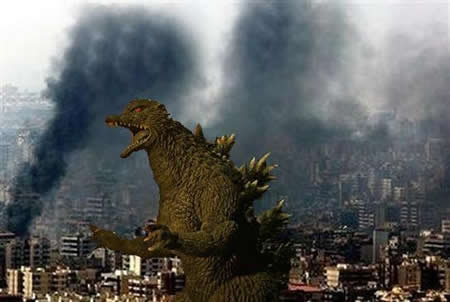
Posted on 08/14/2006 7:44:46 AM PDT by markomalley
The recent discovery that a Lebanese freelance photographer, Adnan Hajj, had manipulated pictures he took for Reuters has raised questions about the standards of photojournalism at a time of widespread digital photography.
The case also increased pressure on news photo editors, who select and edit thousands of photographs under deadline pressure each day, to detect digital alterations.
"The Soviets had to have a whole department to doctor pictures," said David Friend, an editor at Vanity Fair and a former director of photography for Life magazine. "Now all it takes is a swipe of a mouse, and the kid down the street can add smoke and mirrors to everything."
Detecting the smoke and mirrors is a challenge. While editors for print publications commonly rely on editing systems that track changes made to an article, photo editors have fewer such tools at their disposal and often rely on experience and instinct. As a result, skillful manipulation can be difficult to catch.
Careless digital alterations, like Hajj's, are easier to spot. He used a computer program like Adobe Photoshop to darken and duplicate the smoke from an Israeli air strike on Beirut and to add extra dropped flares from an Israeli jet.
(Excerpt) Read more at iht.com ...
Funny.
The writer isn't blaming OUTRIGHT FRAUD and Muslim hatred for the propaganda. Propaganda pushed BY the editors in questions because it supports the editor's positions and intents.
Instead, he is "sympathetic" to the "plight" of the editor being "hoodwinked."
But to the MSM, the agenda is ALL so they happily hire advocates of particular causes which fit their own evil agenda.
For sure the truth is the last thing on the list when it comes to the MSM.
Even then it was too much for Roto-Reuters...
Well, now that that's settled, maybe the media can spend more time staging photos than editing them.(Sarcasm)
Integrity is hard to find these days in the MSM


Long before it was possible to alter photographs, they were used for propaganda purposes. The idea that photographs do not lie is perhaps one of the biggest lie of all.
Time to remember:
Believe only half of what you see and none of what you read!

BUMP!
Thanks for making me laugh out loud this morning....my kids are looking at me weird now....
> ... has raised questions ...
Rubbish. This has been festering since Photoshop was first
released.
The National Geographic, for example, has very strict
standards for what/how photogs must submit.
A publisher who was really concerned would require
that the photogs use only digital cameras that
digitally sign and encrypt each image, and tag it
with GPS-provided time-date-coordinates (in addition
to all the other EXIF data), and submit only
camera .RAW.
What the legacy media is really concerned about here
is that they have been caught, and that fictional
images are now no longer an easy way to boost their
agendas. They will not fix the underlying process flaw.
My sentiments exactly - I'd like to see the DOD mandate that embedded journalists use cameras that embed direction, location, GMT, etc. so that stock or file footage r frames cannot be used ad infinitum to illustrate say the present conditions in Iraq, when they are in fact dramatic photos taken long ago, or in an entirely different location. There has to be a way to integrated GPS, a verifiable time register, perhaps even information as to focal length and aperture into a raw file, encrypt and then pass though a DOD server.
I know digital is easier, but negatives...
It's a long way from the raw photo in the camera's memory or CF card and the published print. Wire services don't want to be in the business of spending time preparing a photo for publication. AP receives several thousand photos a day, it would be a very daunting task to be responsible for cropping, sizing and color correcting that many photos. A lot of the photos they put up on the wire aren't even seen by anyone at AP other than a cursory glance to make sure they are in the right orientation and not upside down. They won't even catch one that's reversed. They put 'em out there and wait to hear from members if they find anything wrong. It's not uncommon for the page designer at a major newspaper to wait until the last possible minute to get art for a front page article from AP and simply download the image and drop it into the hole on the page. They seldom pay any attention at all to the details of a photo. If it looks good on the wire they run with it.
The weak link in the chain is the shooter, it all starts there, and that link is getting weaker and weaker.
Uhhh, how about getting CREDIBLE JOURNALISTS and then you wouldn't have to sift through thousands of photos.
Idiots.
Disclaimer: Opinions posted on Free Republic are those of the individual posters and do not necessarily represent the opinion of Free Republic or its management. All materials posted herein are protected by copyright law and the exemption for fair use of copyrighted works.